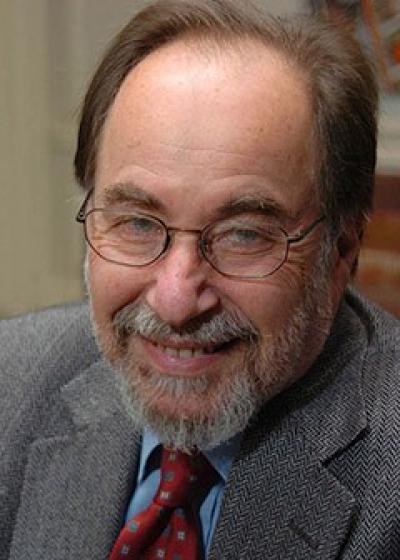
7 questions for Nobel Laureate David Baltimore

Nobel Laureate Dr. David Baltimore “is one of the great scientists of the last 100 years,” said Dr. Keith Jerome, a virologist at Fred Hutchinson Cancer Research Center.
Baltimore’s 1970 discovery of how retroviruses replicate sped the finding a decade later of the retrovirus HIV as the cause of the emerging AIDS pandemic and opened the door for the possibility of treatments. He was the keynote speaker at the 2015 Conference on Cell and Gene Therapy for HIV Cure.
“He’s made a number of fundamental contributions to science, the type of contributions that any scientist would be happy to do once in their careers,” said Jerome, who co-directs defeatHIV, the Hutch-based research consortium that is hosting the conference.
To speak at an HIV cure conference held at a cancer research center is especially appropriate because Baltimore’s work in immunology and virology has profoundly influenced both HIV and cancer research, said Dr. Hans-Peter Kiem, a stem cell transplant researcher and defeatHIV co-director. Baltimore discovered the reverse transcriptase enzyme, for which he shared the 1975 Nobel Prize in Physiology or Medicine, while investigating retroviruses that caused cancer in animals.
“He’s had impact and influence in so many different areas in science,” said Kiem. “He’s touched inflammatory diseases, HIV, cancer — all the immune diseases.”
In the mid-1990s, a cocktail of drugs turned HIV from a death sentence to a manageable chronic disease for those with access to and who can tolerate the treatments. Many of the drugs would not have been possible without Baltimore’s original findings because they inhibit the action of reverse transcriptase in HIV.
Baltimore is now 77 and a professor of biology and president emeritus of the California Institute of Technology. In recent years, he cofounded Calimmune, a private company, to investigate gene therapies to control and potentially cure HIV, which is similar to the approach that defeatHIV is taking.
For Michael Louella, who coordinates defeatHIV’s community advisory board, Baltimore stands out as much for his politics as for his science. The Nobel Laureate co-chaired an influential National Academy of Sciences committee that called for federal spending on HIV/AIDS research.
“That man is vital,” Louella said. “If we do ever end AIDS anywhere on this earth, it’ll be due to the global HIV clinical research effort funded by U.S. taxpayers that was called into being in 1986 thanks to David Baltimore.”
The public is invited to hear Baltimore in conversation with University of Southern California stem cell expert and defeatHIV member Paula Cannon at 7 p.m. Aug. 12 at Fred Hutch’s Pelton Auditorium.
Baltimore talked with a Fred Hutch writer by phone from his office in Pasadena.
You won a Nobel Prize at 37. Did you wake up the next day thinking, “How can I ever top that?”
No.
I didn’t care whether I topped what I’d done before, because that’s a judgment of other people, of history. What I cared about was that I continue to do interesting work that excited me.
Well, I’d say you’ve accomplished that. AIDS first came to public notice in 1981, more than a decade after you discovered reverse transcriptase. When did you start working on HIV?
I was very aware of it and knew what was going on in the field, but I didn’t devote time in my own laboratory to it until 1986. I had been asked by the National Academy of Sciences to do a study on the research needs of the country in relation to HIV. By that time it was clear that it was very difficult to make a vaccine against it, and we hadn’t found drugs that were really controlling it. The study became one of the most cited, most requested studies that NAS had ever done. It’s called “Confronting AIDS,” and it called for a national research program to understand this virus. We pulled out of our hat a number – $1 billion – devoted to research. A billion in those days was real money. It was an audacious report, particularly in the context of the political environment, which was trying to hide from the fact that the AIDS epidemic was occurring. So we were putting ourselves up against the federal government.
One of the things we said in the report was that people with expertise in working with retroviruses ought to bring their expertise to bear on HIV. Many people who were working on different aspects of retroviruses were working solely from the point of view of cancer, and yet they had a lot to offer in HIV. I took that to heart and so began an HIV-related research program in my own laboratory, which I’ve continued to this day.
Outside of your own work, what is the most exciting work being done on HIV today?
There’s exciting work being done on the reservoir [where latent HIV “hides” in the body] and the attempt to provide a cure that would be an endurable elimination of the virus. That has led to a deeper understanding of how pervasive and hard to control the reservoir is.
Another very important piece of work on HIV is on the natural blocks that we have to HIV infection. You can see written in the record of primate evolution many different attempts to block the infection.
In many parts of the U.S., AIDS is kind of out of sight, out of mind due to how successful combination antiretroviral therapy has been. How do you convince people that we need a cure?
Anybody who is taking drugs to control the infection could convince you pretty quickly that controlling the infection with drugs is a non-optimal way of treating the disease because you have to take the drugs forever and they have significant downsides.
What do you really mean when you talk about a cure for HIV?
What many people mean when they say an HIV cure is an elimination of any virus from the patient’s body. I don’t often use the word because it has become so charged, and I’m not interested in getting into a debate about it. For all practical matters, we’ve cured the disease. Anyone who has access to the drugs won’t suffer from the disease today. They may suffer from the drugs, but not the disease.
I think in terms of helping people get to a point where they no longer have to take drugs. That will be good enough. If they can live a normal life and don’t have to take debilitating drugs, I don’t care whether they have some virus left in them.
As a researcher, not a medical doctor, how much did you initially interact with people with HIV?
In my life as an experimental scientist, I had not in fact run into people with HIV. My first involvement was when I ran that commission in Washington. Already the AIDS community was very vocal and it was clear that we needed to have community representation. Some of those people have been friends of mine ever since. What’s amazing is they’re still alive.
Some people are surprised to learn that a cancer research center like Fred Hutch also does HIV research. As a scientist who does both, it seems that you’re in a good position to explain how the two tie together.
It does tie together. A lot of the things we’ve learned in cancer research have helped deal with HIV, and vice versa.
-
Join the conversation: Talk about this story on our Facebook page.
Mary Engel, a staff writer at Fred Hutchinson Cancer Research Center, formerly covered medicine and health policy for newspapers including the Los Angeles Times, where she was part of a team that won a Pulitzer for health care reporting. She also was a fellow at the year-long MIT Knight Science Journalism program. Reach her at mengel@fredhutch.org.
-
reprinted with permission. original article





